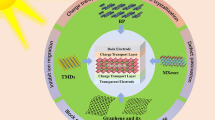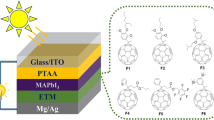Abstract
In this study, a ZnO-Fe2O3 thin film was designed as electron transport layer for organic solar cells (OSCs). The preparation strategy was based on the spin coating of aqueous sol–gel precursor. The result showed that composite ZnO-Fe2O3-based OSCs had higher power conversion efficiency than pure ZnO-based OSCs. To explain this result, morphology, optical and physical properties of ZnO-Fe2O3 were investigated to analyze the relation between structure of interface layer and performance of OSCs. It was demonstrated that composite ZnO-Fe2O3 layer had denser structure and lower surface roughness than pure ZnO layer. Thus, it showed a good contact with the active layer. Furthermore, 3.3% Fe2O3 could reduce the WF and Eg of ZnO, and greatly enhanced electron mobility from the acceptor (IT-4F) phase to the ZnO/ITO electrode. Meanwhile, ZnO-Fe2O3 layer showed a low reflectivity that allowed more photons to entrance the active layer for utilization. Hence, the higher short-circuit current and power conversion efficiency were achieved in ZnO-Fe2O3-based OSCs.

Graphical abstract
Highlights
-
A new aqueous ZnO-Fe2O3 composite sol–gel precursor solution was prepared.
-
ZnO-Fe2O3 was used as electron transport layer for organic solar cells.
-
Efficient organic solar cell could be realized based ZnO-Fe2O3 interface layer.






Similar content being viewed by others
References
Cui Y, Xu H, Yao P, Bi L, Hong J, Zhang Y, Zu T, Zhang J, Qin J, Ren Z, Chen C, He X, Hao Z, Hou J (2021) Single-junction organic photovoltaic cell with 19% efficiency. Adv Mater 33:2102420. https://doi.org/10.1002/adma.202102420
Zhang J, Bai F, Angunawela I, Xu X, Luo S, Li C, Chai G, Yu H H, Y. Chen Y, Hu H, Ma Z, Ade H, Yan H (2021) Alkyl-chain branching of non-fullerene acceptors flanking conjugated side groups toward highly efficient organic solar cell. Adv Energy Mater 11:2102596. https://doi.org/10.1002/aenm.202102596
Xu X, Yu L, Meng H, Dai L, Yan H, Li R, Peng Q (2021) Polymer solar cells with 18.74% efficiency: from bulk heterojunction to interdigitated bulk heterojunction. Adv Funct Mater 32:2108797. https://doi.org/10.1002/adfm.202108797
Ajuria J, Ugarte I, Cambarau W, Etxebarria I, Tena-Zaera R, Pacios R (2012) Insights on the working principles of flexible and efficient ito-free organic solar cells based on solution processed Ag nanowire electrodes. Sol Energy Mater Sol Cells 102:148–152. https://doi.org/10.1016/j.solmat.2012.03.009
Seifter JJ, Sun Y, Choi H, Lee BH, Nguyen TL, Woo HY, Heeger AJ (2015) Measurement of the charge carrier mobility distribution in bulk heterojunction solar cells. Adv Mater 27:4989–4996. https://doi.org/10.1002/adma.201500416
Basta M, Dusza M, Palewicz M, Nawrot U, Granek F (2014) Method to analyze the ability of bulk heterojunctions of organic and hybrid solar cells to dissociate photogenerated excitons and collect free carriers. J Appl Phys 11:174504. https://doi.org/10.1063/1.4875376
Menke SM, Sadhanala A, Nikolka M, Ran NA, Ravva MK, Abdel-Azeim S, Stern HL, Wang M, Sirringhaus H, Nguyen T-Q, Brédas J-L, Bazan GC, Friend RH (2016) Limits for recombination in a low energy loss organic heterojunction. ACS Nano 10(12):10736–10744. https://doi.org/10.1021/acsnano.6b06211
Mandoc MM, Koster LJA (2007) Optimum charge carrier mobility in organic solar cells. Appl Phys Lett 90:133504. https://doi.org/10.1063/1.2711534
Stolterfoht M, Shoaee S, Armin A, Jin H, Kassal I, Jiang W, Burn P, Meredith P (2017) Electric field and mobility dependent first-order recombination losses in organic solar cells. Adv Energy Mater 7:1601379. https://doi.org/10.1002/aenm.201601379
Zhang X, Fan P, Han Y, Yu J (2019) Effect of crystallinity modulation between electron transport layer and photo-generation materials on ZnO-based polymer solar cells. Energy Technol 7:263–268. https://doi.org/10.1002/ente.201800666
You JB, Meng L, Song TB, Guo TF, Yang YM, Chang WH, Hong Z, Chen HJ, Zhou HP, Chen Q, Liu YS, Marco ND, Yang Y (2016) Improved air stability of perovskite solar cells via solution-processed metal oxide transport layers. Nat Nanotechnol 11:75–81. https://doi.org/10.1038/NNANO.2015.230
Wu WQ, Chen DH, Caruso RA, Cheng YB (2017) Recent progress in hybrid perovskite solar cells based on n-type materials. J Mater Chem A 5:10092–10109. https://doi.org/10.1039/c7ta02376f
MacLeod BA, Tremolet De Villers BJ, Schulz P, Ndione PF, Kim H, Giordano AJ, Zhu K, Marder SR, Graham S, Berry JJ, Kahn A, Olson DC (2015) Stability of inverted organic solar cells with ZnO contact layers deposited from precursor solutions. Energ Environ Sci 8:592–601. https://doi.org/10.1039/c4ee02488e
Khan JA, Sharma R, Sarkar SK, Panwar AS, Gupta D (2019) Combined effect of ZnO nanoripples and solvent additive on the nanomorphology and performance of PTB7-Th: PC71BM organic solar cells. Nanotechnology 30:385204. https://doi.org/10.1088/1361-6528/ab1ec6
Liu ZX, Hu R, Yu JS, Wang RL, Cheng J, Huo MM, Wu TQ, Li L (2021) Fabrication of ZnO interface layer from a novel aqueous sol-gel precursor solution for organic solar cells. Synth Met 274:116737. https://doi.org/10.1016/j.synthmet.2021.116737
Karunakaran C, Senthilvelan S (2006) Fe2O3-photocatalysis with sunlight and UV light: oxidation of aniline. Electrochem Commun 1:95–101. https://doi.org/10.1016/j.elecom.2005.10.034
Park EK, Choi MJ, Jeun JH, Lim KT, Kim JM, Kim YS (2013) The effect of metal oxide nanoparticle concentrations in PEDOT:PSS layer on the performance of P3HT:PCBM organic solar cells. Microelectron Eng 111:166–169. https://doi.org/10.1016/j.mee.2013.03.103
Park EK, Kim JH, Cho HJ, Lee DH, Kim YS (2015) Analysis of charge transfer and recombination for the poly(3-hexylthiophene):[6,6]-phenyl C61 butyric acid methyl ester organic solar cells with iron oxide nanoparticles in various layers. Appl Phys Lett 107:153903. https://doi.org/10.1063/1.4933270
Mondelaers D, Vanhoyland G, van den Rul H, D’Haen J, van Bael MK, Mullens J, van Poucke LC (2003) Chemical solution deposition of ZnO thin films by an aqueous solution gel precursor route. J Solgel. Sci Technol 26:523–526. https://doi.org/10.1023/A:1020703500515
Wang Y, Liang Z, Li X, Qin J, Ren M, Yang C, Bao X, Xia Y, Li J (2019) Self-doping n-type polymer as a cathode interface layer enables efficient organic solar cells by increasing built-in electric field and boosting interface contact. J Mater Chem C 7:1115211159. https://doi.org/10.1039/c9tc03506k
Zhang L, Reisner E, Baumberg JJ (2014) Al-doped ZnO inverse opal networks as efficient electron collectors in BiVO4 photoanodes for solar water oxidation. Energy Environ Sci 7:1402–1408. https://doi.org/10.1039/c3ee44031a
Liu CY, Zhang DZ, Lu FB, Tan MR, Luan TT, Wu HY, Zhang BC, Shen L, Guo WB (2018) Overcoming defect-induced charge recombination loss in organic solar cells by förster resonance energy transfer. ACS Sustain Chem Eng 6:9699–9706. https://doi.org/10.1021/acssuschemeng.8b00604
Hou GQ, Gao SJ, Zhang WL (2013) Study on the photocatalytic properties with different ratio films of ZnO:Fe2O3. AMR 750–752:1836–1839. https://doi.org/10.4028/www.scientific.net/AMR.750-752.1836
Shen YM, Chen CS, Yang PC, Ma SY, Lin CF (2012) Improvement of surface morphology of thin films and performance by applying electric field on P3HT:PCBM based solar cells. Sol Energy Mater Sol Cells 99:263–267. https://doi.org/10.1016/j.solmat.2011.12.008
Kumar S, Upadhyay R, Pradhan B (2020) Performance enhancement of heterojunction ZnO/PbS quantum dot solar cells by interface engineering. Sol Energy 211:283–290. https://doi.org/10.1016/j.solener.2020.09.063
Fan QP, Su WY, Wang Y, Guo B, Jiang YF, Guo X, Liu F, Russell TP, Zhang MJ, Li YF (2018) Synergistic effect of fluorination on both donor and acceptor materials for high performance non-fullerene polymer solar cells with 13.5% efficiency. Sci Chin Chem 61:531–537. https://doi.org/10.1007/s11426-017-9199-1
Liu T, Ma RJ, Luo ZH, Guo Y, Zhang GY, Xiao YQ, Yang T, Chen YZ, Li G, Yi YP, Lu XH, Yan H, Tang B (2020) Concurrent improvement in JSC and VOC in high-efficiency ternary organic solar cells enabled by a red-absorbing small-molecule acceptor with a high LUMO level. Energy Environ Sci 13:2115–2123. https://doi.org/10.1039/d0ee00662a
Dai Q, Liu WM, Zeng LT, Lee CS, Wu JS, Wang PF (2011) Aggregation-induced emission enhancement materials with large red shifts and their self-assembled crystal microstructures. Cryst Eng Comm 13:4617–4624. https://doi.org/10.1039/c1ce05035d
Chen MX, Liu D, Li W, Gurney RS, Li DH, Cai JL, Spooner ELK, Kilbride RC, McGettrick JD, Watson TM, Li Z, Jones RAL, Lidzey DG, Wang T (2019) Influences of non-fullerene acceptor fluorination on three-dimensional morphology and photovoltaic properties of organic solar cells. ACS Appl Mater Int 9:26194–26203. https://doi.org/10.1021/acsami.9b07317
Ullah SS, Robinson M, Hoey J, Driver MS, Caruso AN, Schulz DL (2012) Work function characterization of solution-processed cobalt silicide. Semicond Sci Technol 27:065012. https://doi.org/10.1088/0268-1242/27/6/065012
Salim MB, Nekovei R (2019) Electronic properties and molar excitation coefficient for organic solar cells materials by using TD-DFT method. In: Proceedings of the IEEE 46th photovoltaic specialists conference (PVSC) 0429-0433. https://doi.org/10.1109/PVSC40753.2019.8980795
Ridzonova K, Belas K, Grill R, Pekarek J, Praus P (2020) Space-charge-limited photocurrents and transient currents in (Cd,Zn)Te radiation detectors. Phys Rev Appl 6:13. https://doi.org/10.1103/PhysRevApplied.13.064054
Sharma V, Singh V, Arora M, Arora S, Tandon RP (2016) Degradation analysis of PCDTBT:PC71BM organic solar cells-an insight. Curr Appl Phys 3:273–277. https://doi.org/10.1016/j.cap.2015.12.007
Acknowledgements
This research was funded by the Science and Technology Research Program of Chongqing Municipal Education Commission (KJQN201901319, KJQN202001323), General program of Chongqing Natural Science Foundation (cstc2019jcyj-msxmX0874, cstc2019jcyjjqx0021), Major Cultivation Project of Chongqing University of Arts and Sciences (P2020CL01), and Key Program of Yongchuan District Natural Science Foundation (2022yc-jckx20017).
Author information
Authors and Affiliations
Corresponding author
Ethics declarations
Conflict of interest
The authors declare no competing interests.
Additional information
Publisher’s note Springer Nature remains neutral with regard to jurisdictional claims in published maps and institutional affiliations.
Supplementary Information
Rights and permissions
About this article
Cite this article
Tian, Z., Wu, T., Hu, R. et al. Enhanced efficiency of organic solar cells by using a ZnO-Fe2O3 electron transport layer. J Sol-Gel Sci Technol 103, 890–897 (2022). https://doi.org/10.1007/s10971-022-05877-y
Received:
Accepted:
Published:
Issue Date:
DOI: https://doi.org/10.1007/s10971-022-05877-y




